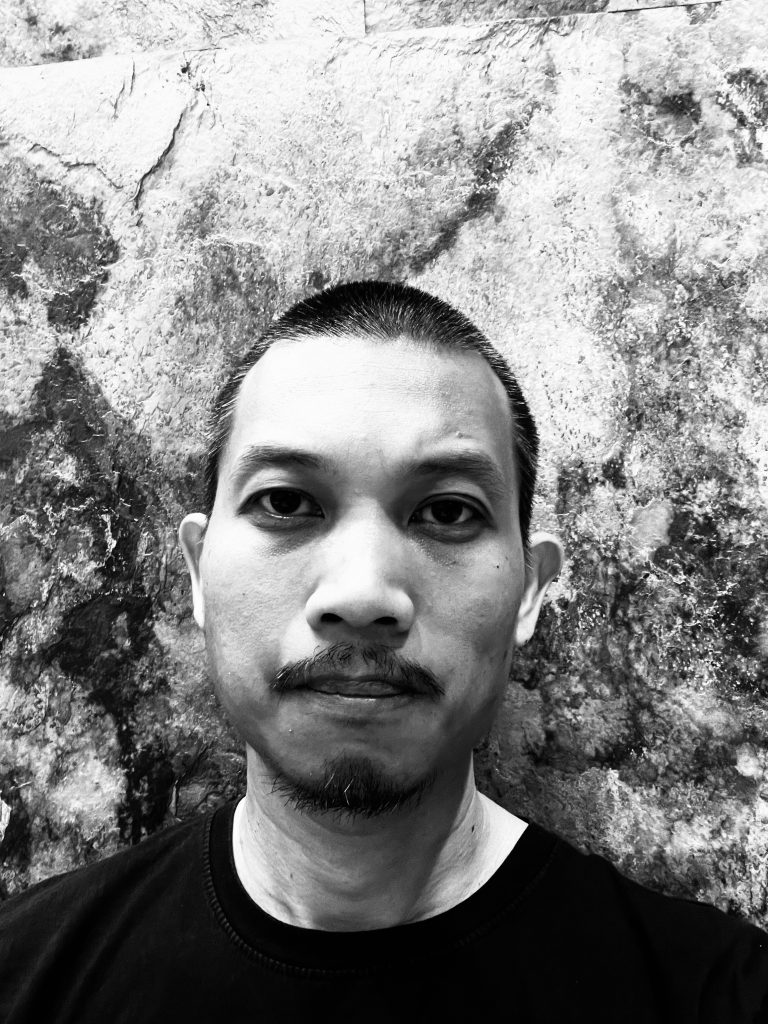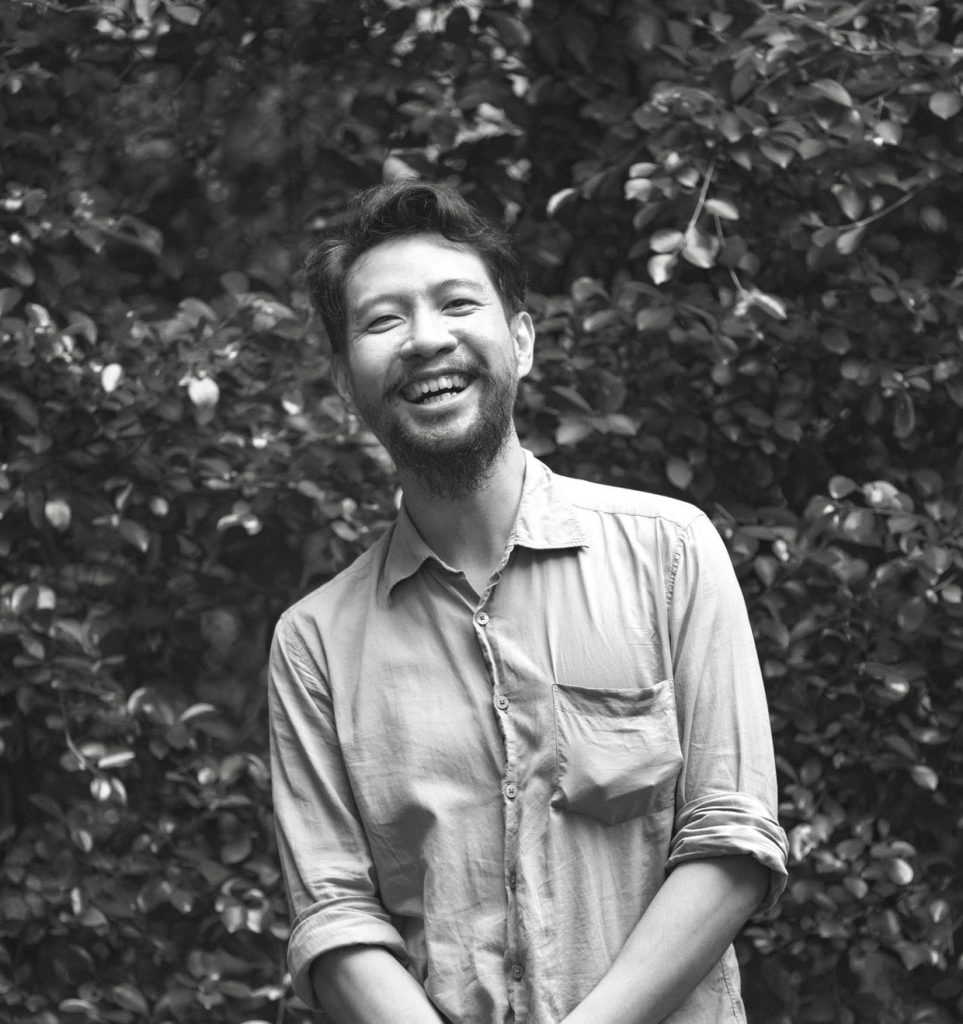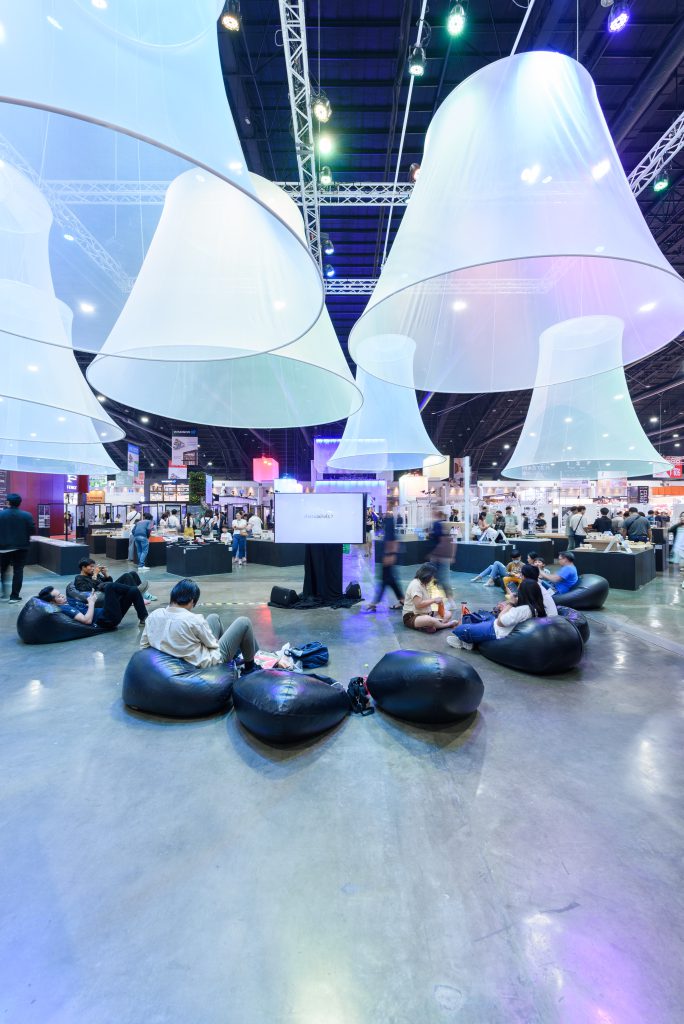The exhibition “ASA ALL MEMBER: Collective Practices,” curated by Jaturon Kingminghae and Yan Phornphong from Creative Territories, presented a comprehensive perspective on ‘Behind the Scene’ of professional roles to the general public while providing motivation and inspiration for those within the design industry.

ภายในงานสถาปนิก’67 ซึ่งนำเสนอบนแนวคิด “Collective Language : สัมผัส สถาปัตย์” ด้วยต้องการสร้างการรับรู้ สื่อสาร และส่งต่อผ่านภาษาทางสถาปัตยกรรมและการออกแบบอันไร้ขอบเขต ซึ่งเน้นย้ำพร้อมไปกับเชื่อมโยงผู้คนในโลกแวดวงการออกแบบ ผ่านทั้งรูปแบบการสื่อสารผ่านประสบการณ์ การแลกเปลี่ยนความรู้ และผลงานในลักษณะที่หลากหลาย เพื่อขยายภาพการเชื่อมโยงทางวิชาชีพและผลักดันการสื่อสารงานสถาปัตยกรรมในหลากหลายมิติ ให้สามารถเข้าถึงได้ทั้งกลุ่มวิชาชีพและบุคคลทั่วไป ณ ชาเลนเจอร์ฮอลล์ 1-3 ศูนย์แสดงสินค้าและการประชุมอิมแพ็ค เมืองทองธานี ระหว่างวันที่ 30 เมษายน – 5 พฤษภาคม 2567 ที่ผ่านมา
“ASA ALL MEMBER :Collective Practices” เป็นหนึ่งในนิทรรศการหลักของงานที่ตั้งอยู่ส่วนปลายทิศทางตรงกันข้ามกับนิทรรศการธีมงาน ซึ่งล้อรับไปกับแนวคิด ในข้างต้น หากแต่ปรับแปลงและส่งมอบต่อด้วยสัมผัส “วิชาชีพ” อันนำเสนอและเปิดโอกาสให้ทุกคนร่วมเป็นส่วนหนึ่งบนผืนภูมิทัศน์จากการร้อยเรียงหลากหลายผลงาน เพื่อฉายขยายภาพที่ครอบคลุมไปยัง “พื้นที่ออฟฟิศ ผู้คน และแนวทางการทำงาน” ที่จะเอื้อให้สามารถก่อประกอบเป็นชุดความเข้าใจยัง “เบื้องหลัง” บทบาทผู้ประกอบวิชาชีพต่อบุคคลทั่วไป ผู้เข้าชม รวมไปถึงเป็นแรงผลักดันและแรงบันดาลใจในการออกแบบแก่ผู้ที่อยู่แวดวงอุตสาหกรรมการออกแบบ ซึ่งรับผิดชอบดูแลและจัดการโดย จาตุรนต์ กิ่งมิ่งแฮ และ ยัญญเดช พรพงษ์ สองภัณฑารักษ์จากออฟฟิศออกแบบสถาปัตยกรรม Creative Territories ที่มุ่งความสนใจไปกับกระบวนการศึกษาค้นคว้า สหวิทยาการ และปรารถนาที่จะตอบแทนบางสิ่งบางอย่างสู่กลุ่มวิชาชีพ
ภัณฑารักษ์ของนิทรรศการ ASA ALL MEMBER: Collective Practices
“เนื่องจากเราค่อนข้างให้ความสำคัญกับกระบวนการรีเสิร์ชค้นหา และรวบรวมความรู้ในหลาย ๆ ด้าน รวมไปถึงแนวทางการทำงานออฟฟิศของเรา ก็มุ่งความสนใจไปในกระบวนการทำงานร่วมกันระหว่างหลากหลายสาขาความรู้ ที่ข้ามศาสตร์แลกเปลี่ยนซึ่งกันและกัน โดยเราก็เชื่อว่ากระบวนการเหล่านี้จะนำสู่กระบวนการคิด การสร้างสรรค์สิ่งใหม่ ๆ แล้วเราก็คิดว่า จะสามารถเบิกลู่ทางไปสู่การค้นพบศักยภาพใหม่ ๆ ของสิ่งเหล่านั้นได้” (จาตุรนต์)
จาตุรนต์สำเร็จการศึกษาจากคณะสถาปัตยกรรมศาสตร์ จุฬาลงกรณ์มหาวิทยาลัย ขณะที่ยัญญเดชจบการศึกษาทั้งระดับปริญญาตรีและปริญญาโทจากคณะสถาปัตยกรรมศาสตร์และการผังเมือง มหาวิทยาลัยธรรมศาสตร์ ทั้งสองต่างใช้ช่วงขณะของการเริ่มต้นปฏิบัติ การทางวิชาชีพและค้นหาตนเองในออฟฟิศออกแบบในต่างประเทศ ต่อมาเมื่อถึงจุดอิ่มตัวประกอบกับความต้องการขับเน้นกระบวนการออกแบบตามที่มุ่งสนใจผ่านผลงานได้อย่างอิสระและเป็นตัวเอง จาตุรนต์จึงตัดสิน ใจร่วมก่อตั้ง Creative Territories ออฟฟิศออกแบบสถาปัตยกรรมกับพาร์ทเนอร์ขึ้นในปี 2018
แม้ยัญญเดชจะร่วมเป็นส่วนหนึ่งของทีมในปีถัดมาด้วยตำแหน่งสถาปนิกอาวุโส แต่ทั้งสองต่างคุ้นเคยกันเป็นอย่างดี เนื่องจากก่อนหน้านั้น พวกเขาได้พบและมีโอกาสร่วมงานกันมายาวนานกว่า 10 ปี และด้วยความสอดคล้องระหว่างแนวทางการทำงานของออฟฟิศกับวิธี การคิดส่วนตัวของยัญญเดชในวิธี การออกแบบที่เน้นกระบวนการคิดแบบใช้เหตุและผล ผนวกกับอีกส่วนอย่างการให้ความสำคัญกับการรวบรวมแนวคิด และองค์ความรู้ที่หลากแขนง มาประกอบรวมไว้ด้วยกัน เพื่อที่จะตั้งคำถามและกระตุ้นให้เกิดบทสนทนา ด้วยต้องการไปสู่ผลลัพธ์ที่ดีที่สุดบนพื้นฐานข้อจำกัดจากทุกมิติ มุมมองบนความเป็นไปได้ ซึ่งเน้นย้ำถึงกรอบการทำงานที่มุ่งให้ความสนใจอย่างหลากหลายพร้อมทั้งขยายตัวอยู่เสมอ พวกเขาจึงได้กลับมาออกแบบด้วยรูปแบบปฏิบัติ การทางความคิดที่ต่างสนใจร่วมกันอีกครั้ง ด้วยความมุ่งมั่นเพื่อการบริการสู่สาธารณะและวิชาชีพนักออกแบบอันเป็นแนวทางหลักในการทำงานของทั้งสอง ก็ประจวบเหมาะพอดีกับการเล็งเห็นถึงศักยภาพในกระบวนการทำงานของ ยัญญเดชจาก ชุตยาเวศ สินธุพันธุ์ หนึ่งในประธานผู้จัดงานในครั้งนี้ ซึ่งยัญญเดชเคยชนะงานประกวดแบบ ASA Experimental Design Competition เมื่อปี 2019 พร้อมกับได้รับทุนในการศึกษาจากทางสมาคมสถาปนิกสยาม ในพระบรมราชูปถัมภ์ ร่วมกับ Aoyama Design Forum (ADF) ของประเทศญี่ปุ่น สองนักออกแบบจึงได้รับพิจารณาให้รับผิดชอบดูแลนิทรรศการในส่วน ASA ALL MEMBER และนิทรรศการเนื่องในโอกาสครบ 90 ปีสมาคมสถาปนิกสยามฯ “อีกทั้งประธานจัดงานในปีนี้ ได้เปิดโอกาสให้กลุ่มคนรุ่นใหม่ เพื่อสร้างความสดใหม่ให้กับงานนิทรรศการ นี่จึงเป็นอีกหนึ่งที่มาซึ่งเราได้รับเลือกให้เข้าไปทำ” ยัญญเดชกล่าวเสริม
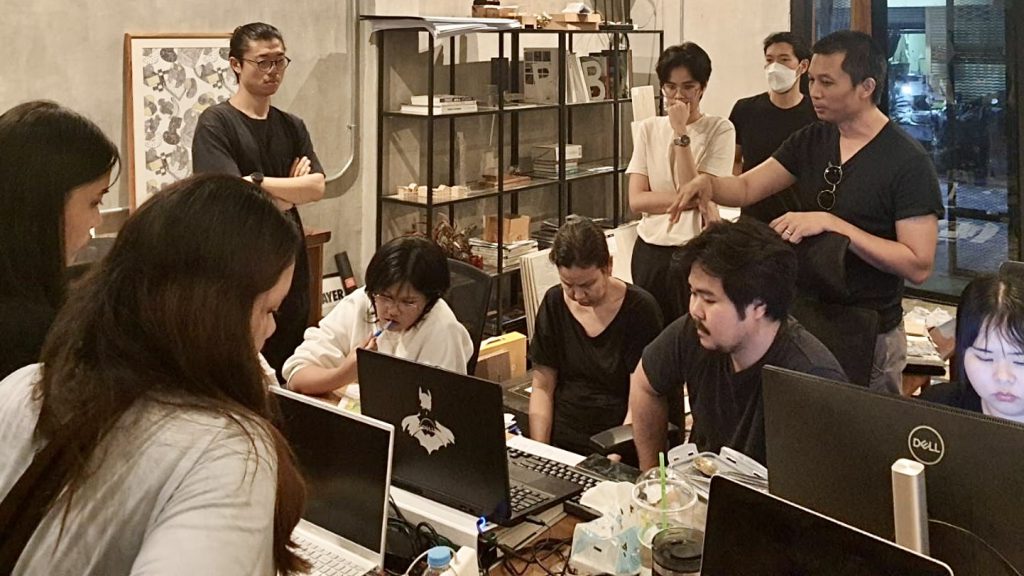
สัมผัส “วิชาชีพ”
“ที่ผ่านมาในแต่ละปีของงาน ASA ALL MEMBER ก็จะจัดขึ้นตามธีมต่าง ๆ สลับปรับเปลี่ยนเรื่อยมา และแน่นอนว่า เราก็ได้สัมผัสรับชมในทุก ๆ ปีที่ผ่านมา เราจึงเริ่มถามคำถามต่อว่ามากไปกว่าการจัดแสดงเพียงสิ่งสวยงาม สามารถมีอะไรที่มากไปกว่านั้นได้หรือไม่ เมื่อเราได้รับโอกาสเป็นผู้ดูแลและรับผิดชอบจัดงาน งานในครั้งนี้ เราจึงต้องการอยากจะนำเสนอต่อยอดจากแนวคิดตรงนี้ คือเราก็มีความตั้งใจที่อยากจะให้งานแสดงในครั้งนี้สามารถยกระดับวิชาชีพของเราขึ้นไปอีกขั้น หมายความว่า เราต้องการให้ผู้เข้าชมทั้งที่อยู่แวดวงในวิชาชีพและบุคคลทั่วไปได้รับรู้เข้าใจถึงเบื้องลึกเบื้องหลังของวิชาชีพเราได้อย่างชัดเจน” (จาตุรนต์)
สำหรับผลงานออกแบบที่จัดแสดงเป็นงานสร้างสรรค์ของสมาชิกสมาคมวิชาชีพต่าง ๆ ไม่เพียงแต่สมาชิกของสมาคมสถาปนิกสยามฯ เท่านั้น ยังรวมไปถึงสมาคมมัณฑนากรแห่งประเทศไทย (TIDA) สมาคมสถาปนิกผังเมืองไทย (TUDA) และสมาคมภูมิสถาปนิกประเทศไทย (TALA) อีกด้วย การร่วมจัดแสดงผลงานของทั้งสี่สมาคม ขณะหนึ่งก็ได้เสนอภาพวิชาชีพที่หลากหลาย อันเกี่ยวโยงกันผ่านกระบวนการออกแบบ อีกทั้งยังสะท้อนให้เห็นถึงความร๋วมมือในการทำงานระหว่างวิชาชีพไปพร้อม ๆ กัน ด้วยรูปแบบการเรียบเรียงจัดวางที่สลับสับวางต่อตามลำดับการจัดส่งผลงาน โดยในปีนี้มีทั้งสมาชิกเดิม รวมถึงบริษัทและบุคคลทั่วไปผู้สนใจที่ร่วมสมัครเป็นสมาชิกสมาชิกใหม่เข้าร่วมจัดแสดงหนึ่งร้อยกว่าราย
ภายในพื้นที่จัดแสดงได้วางผังแบ่งผลงานออกเป็นสองส่วนหลัก อันประกอบด้วยผลงานของสมาชิกของทั้งสี่สมาคมฯ ที่จัดแสดงผลงานออกแบบทั้งที่แล้วเสร็จ ไม่แล้วเสร็จ ไม่ได้สร้างจริง หรือเพียงส่วนใดส่วนหนึ่งของผลงาน ด้วยรูปแบบวัตถุสามมิติหรือโมเดล หรือในรูปแบบเพลทสามเหลี่ยมที่ติดตั้งวางบนฐานรูปทรงสี่เหลี่ยมสีดำ พร้อมกับป้ายแสดงข้อมูลเบื้องต้นเกี่ยวกับผลงานที่มากับ QRCode ซึ่งเมื่อสแกนแล้วก็จะสามารถเข้าถึงข้อมูลรายละเอียดส่วนอื่น ๆ ที่สัมพันธ์ตามผู้เข้าร่วมได้จัดส่งประกอบ เพื่อให้สอดรับไปกับแนวคิด ของสองภัณฑารักษ์ที่ต้องการนำเสนอมุมมองการทำงาน “เบื้องหลัง” ของวิชาชีพนักออกแบบให้สามารถเข้าถึงได้และเกิดการแลกเปลี่ยนเรียนรู้ซึ่งกันและกัน ด้วยการนำเสนอข้อมูลเกี่ยวกับกระบวนการการออกแบบของแต่ละออฟฟิศ บุคลากร และพื้นที่ทำงาน (Process/ People/ Place) เป็นอีกสามส่วนข้อมูลที่ถูกให้ความสำคัญไม่แพ้กัน โดยข้อมูลภาพหรือวิดีโอในส่วนนี้ยังจะถูกนำไปฉายถ่ายทอดผ่านจอโทรทัศน์ในบริเวณจุดกลางของพื้นที่นิทรรศการที่ให้ผู้คนได้เอนกายลงบนฟูกและรับชม
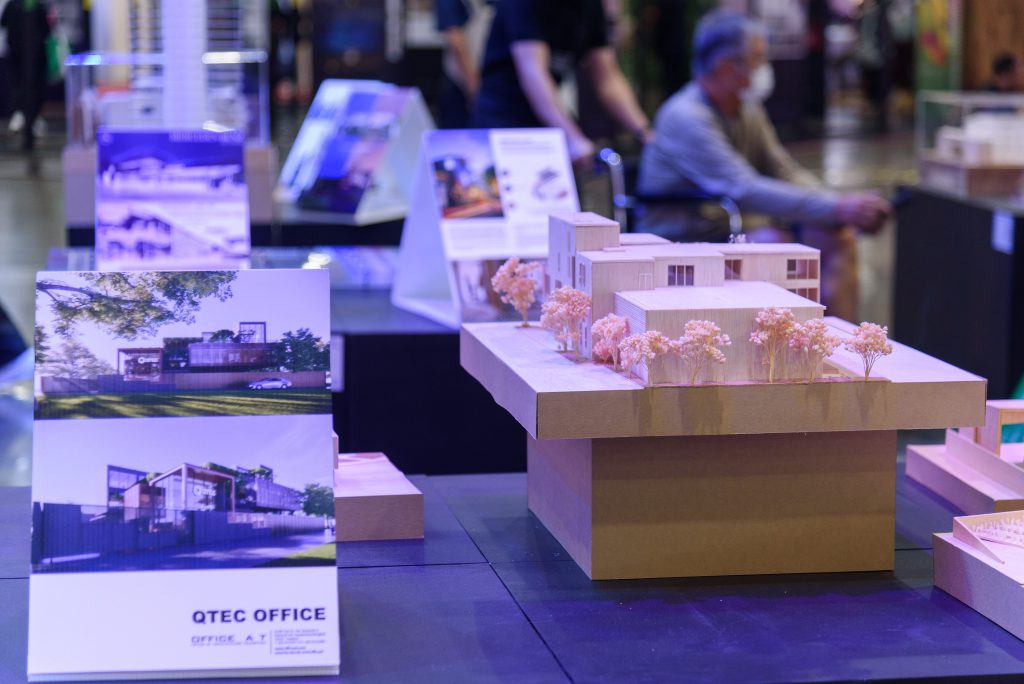
สร้างสัมผัสจาก “ข้อมูล”
ขณะที่นิทรรศการอีกส่วนเป็นการที่จัดแสดงเผยแพร่ชุดข้อมูลบนแท่นแนวยาวที่จัดวางขนานกันเป็นคู่ด้านซ้ายและขวาภายในพื้นที่ โดยแต่ละส่วนจะนำเสนอข้อมูลที่สอดรับ พร้อมกับส่งเสริมสร้างให้เกิดประเด็นไปกับข้อมูลในสามส่วนข้างต้น โดยแทรกข้อมูลในเชิงการทำงานวิชาชีพออกแบบร่วมเข้าไป ในรูปแบบการตั้งคำถาม พร้อมนำเสนอข้อมูลจากการรวบรวม ค้นคว้า และสังเคราะห์ นำเสนอข้อมูลในแต่ละด้าน ทั้งในเชิงประวัติศาสตร์และสถิติ ผ่านรูปแบบข้อมูลอินโฟกราฟิกที่รวบยอดความคิดที่สำคัญให้สามารถเข้าใจได้อย่างง่ายดาย โดยในส่วนนี้ เองที่ได้จัดแสดงข้อมูลเนื่องในโอกาสครบรอบ 90 ปี สมาคมสถาปนิกสยามฯ ที่โดดเด่นจากส่วนอื่น ๆ ด้วยการนำเสนอประกอบการจัดวางคู่ไปกับหนังสือที่เกี่ยวข้อง รวมไปถึงวารสารอาษา และสื่อสิ่งพิมพ์ที่เผยแพร่ในช่วงแรกโดยสมาคมฯ อันเป็นสิ่งทรงคุณค่าและเข้าถึงได้อย่างจำกัดโดยทั่วไป ร่วมไปกับการสร้างพื้นที่แสดงความคิด เห็นปลายเปิดให้ผู้ชมสามารถเขียนแสดงความเห็นถึงทิศทางที่คาดหวังจากวิชาชีพนักออกแบบ นี่จึงนับว่าเป็นโอกาสอันดีซึ่งผู้เข้าร่วมจะสามารถรับชมและเรียนรู้ผ่านทั้งข้อมูลในเชิงลึกจากการศึกษาค้นคว้า พร้อมไปกับวัตถุจัดแสดงที่เกี่ยวข้องอันห่อหุ้มไว้ด้วยความหมายความสำคัญซึ่งได้เข้ามาส่งเสริมประกอบสร้างให้เกิดเป็นประสบการณ์การเรียนรู้สุดแสนพิเศษ
“ตามการจัดวางผังของแท่นทั้งสี่ ในส่วนซ้ายล่างจะเป็นส่วนที่จัดแสดงข้อมูลเกี่ยวกับ 90 ปี สมาคมสถาปนิกฯ วารสารอาษา กำเนิดงานสถาปนิก และในอีกส่วนถ้าหากเรียงตามคำถามในรูปแบบใคร ทำอะไร ที่ไหน อย่างไร และอยู่ภายใต้สมาคมฯ อย่างไร ก็เป็นไปตามนี้คือ ทางขวาล่าง ก็จะนำเสนอว่าสถาปนิกเป็นใคร คือการบอกเล่าถึงบทบาทหน้าที่ นิยามของสถาปนิก และกว่าจะเป็นสถาปนิกต้องเรียนอะไรบ้าง ต่อมาทางด้านซ้ายบน จะเป็นในส่วนที่ถ่ายทอดว่าสถาปนิกทำงานอย่างไร ตีแผ่กระบวนการออกแบบเป็นอย่างไรบ้าง รวมไปถึงเครื่องมือในการออกแบบ สุดท้ายทางด้านขวาบนจะบรรยายให้เห็นว่า สถาปนิกทำงานที่ไหน หน้าตาออฟฟิศเป็นอย่างไร โดยทั้งสี่แกนนี้ก็จะช่วยให้ผู้เข้าชมเห็นภาพกว้างของวิชาชีพ อีกทั้งทำหน้าที่เป็นแกนหลักที่ช่วยร้อยเรียงยูนิตย่อย ๆ ของผลงานออกแบบในส่วนของสมาชิกเข้าไว้ด้วยกัน” (ยัญญเดช)

อาจกล่าวได้ว่า ส่วนสำคัญที่ช่วยขับเคลื่อนให้การจัดแสดงนิทรรศการ ASA ALL MEMBER ในปีนี้แตกต่างออกไป นั่นคือการจัดแสดงร่วมไปกับชุดข้อมูลจากกระบวนการสืบค้นและศึกษาของสองภัณฑารักษ์ที่รวบรวมขึ้นจากสำนักงานออกแบบสมาชิกและที่ตอบรับเข้าร่วมจัดแสดง ร่วมไปกับฐานข้อมูลของทางสมาคมที่เคยเก็บรวบรวม เนื่องจากเนื้อหาข้อมูลในส่วนดังกล่าวได้สรุปรวบยอดฉายเป็นภูมิทัศน์ของวิชาชีพสถาปนิกให้เห็น สามารถสัมผัสและเข้าใจได้ นับแต่จุดเริ่มต้นความเป็นมา นิยามของสถาปนิก กระทั่งพื้นที่การทำงาน และพัฒนาการเครื่องมือ โปรแกรมที่สถาปนิกใช้ ที่ไม่เพียงแต่จะพิจารณาเฉพาะเพียงข้อมูลเชิงประวัติศาสตร์ภายในไทยเพียงเท่านั้น ในบางช่วงของชุดข้อมูลก็มีการนำเสนอเปรียบเทียบกับความเป็นไปในระดับสากล เพื่อสะท้อนให้เห็นการส่งอิทธิพลและการตอบรับภายในประเทศไปพร้อมกัน นอกไปจากนั้นแล้วอีกส่วนหนึ่งซึ่งแทรกอยู่ในทุกชุดข้อมูลที่นำเสนอและช่วยเสริมสร้างให้เกิดความน่าสนใจให้กับข้อมูลในแต่ละส่วนคือการสอบถามเก็บข้อมูลไปกับกลุ่มสมาชิกผู้เข้าร่วม และนำเสนอในรูปแบบของคำถามประกอบโควท
คำตอบ ยกตัวอย่างเช่น “เอไอจะมาแทนที่สถาปนิก?” “อยากเห็นวิชาชีพเป็นอย่างไรในอนาคต?” หรือ “อยากให้คนทั่วไปรู้จักสถาปนิกอย่างไร?” โดยได้ช่วยให้สามารถเข้าถึงและเกิดเป็นความเข้าใจ อันนำไปสู่การเรียนรู้ต่อยอด อีกทั้งปรับพัฒนาได้อย่างหลากหลายผ่านการวิเคราะห์และพิจารณาด้วยชุดข้อมูลเหล่านั้น เช่น “วิชาชีพที่พัฒนาคุณภาพของ built environment ที่จำเป็นในสังคมและบริบทที่แตกต่างและเหมาะสมของแต่ละคน” หรือ “สถาปนิกเป็นอีกหนึ่งวิชาชีพที่มีบทบาทสำคัญต่อคน กลุ่มคน ชุมชน และเมือง
การที่คนทั่วไปตระหนักถึงความสำคัญของวิชาชีพนี้จะช่วยให้เกิดการสร้างเมืองอย่างยังยืน และช่วยพัฒนา/ ส่งเสริมวิชาชีพให้เติบโต แข็งแรง” ซึ่งเป็นโควทประกอบตัวอย่างคำถามลำดับสุดท้าย
นิทรรศการ ASA ALL MEMBER :Collective Practices จึงนับได้ว่ามีส่วนสำคัญที่เข้ามาช่วยเติมเต็มและสร้างความเข้าใจต่อวิชาชีพนักออกแบบให้กับผู้เข้าชมโดยทั่วไปได้อย่างเปิดกว้างสำหรับงานสถาปนิก’67 ในครั้งนี้ เนื่องด้วยรูปแบบสื่อนำเสนอที่ดึงดูดชวนให้ติดตาม อันนำไปสู่การทำความเข้าใจไปบนความหลากหลาย ที่ยังถูกเน้นย้ำให้เห็นถึงการเปิดรับโต้ตอบ ทั้งในแง่ข้อมูลที่เปิดให้สมาชิกที่เข้าร่วมได้แสดงความคิดเห็น ซึ่งในจุดนี้เองที่จะช่วยขยายความ ส่งต่อและเคลื่อนให้ผู้ชมเกิดปฏิสัมพันธ์ร่วมไปกับนิทรรศการไม่เพียงการได้รับชม แต่พวกเขายังจะได้คิด อันนำไปสู่บางสิ่งบางอย่าง ที่จะช่วยต่อยอดให้นิทรรศการขยับขับเคลื่อนและพัฒนาด้วยความคิดเห็นที่ถูกแสดงออกมาในหลากหลายมิติ ดังที่สองภัณฑารักษ์ต้องการ
“เนื่องจากผมได้มีโอกาสปฏิบัติงาน ณ บริเวณนิทรรศการทุกวันก็จะสังเกตเห็นปฏิกิริยาของผู้คนในหลากหลายเหตุการณ์ เช่น พ่อแม่ที่เดินทางมาพร้อมกับลูกซึ่งเป็นสถาปนิกและเพิ่งจะได้เริ่มทำงานมาไม่นาน แต่หลังจากชมสื่อข้อมูลที่จัดแสดงแล้ว พวกเขาจึงเพิ่งเข้าใจอย่างแท้จริงถึงขอบเขตภาระหน้าที่รับผิดชอบของลูกตนเอง หรือผู้เข้าชมบางท่านก็ได้ทราบว่านอกเหนือจากงานออกแบบแล้ว สถาปนิกยังจำเป็นจะต้องเข้าใจงานทางด้านกฎหมายอีกด้วย หรือในแง่มุมทางวิชาการจากอาจารย์ที่สอนในโรงเรียนสถาปัตย์แห่งหนึ่งก็ได้เสนอความเห็นไว้ว่า นิทรรศการในครั้งนี้ค่อนข้างน่าสนใจเป็นอย่างยิ่ง โดยเฉพาะข้อมูลในส่วนไทม์ไลน์อินโฟกราฟิกจากการสืบค้น รวบรวม และสรุป ซึ่งถ่ายทอดสัมพันธ์ไปกับแง่มุมเศรษฐกิจ สังคม และการเมือง น่าจะต่อยอดและเข้าบรรจุไว้ในบทเรียน หรืออีกมุมมองของคนในสมาคมฯ เองที่ไม่ได้รับผิดชอบดูแลในส่วนนี้ก็กล่าวว่า เขายังอยากให้ข้อมูลที่จัดแสดงภายในนิทรรศการครั้งนี้ ได้ถูกรวบรวมและนำไปเผยแพร่ในรูปแบบหนังสือและเว็บไซต์ เพื่อให้ผู้ที่ไม่ได้ร่วมงานสามารถเข้าถึงข้อมูลชุดดังกล่าวได้เช่นกัน” (ยัญญเดช)
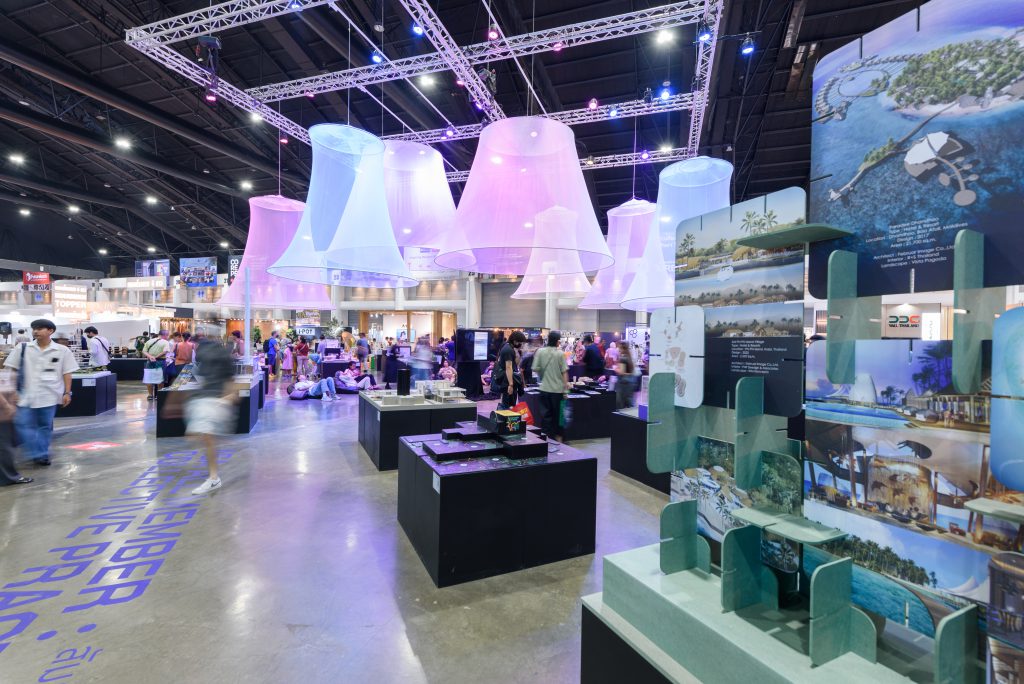
Themed “Collective Language” Architect Expo 2024 aimed to raise awareness, foster communication, and articulate ideas through the limitless language of architecture and design. This concept emphasized connecting individuals within the design world through experiential communication, knowledge exchanges, and diverse works. The objective was to expand professional connectivity and promote architectural dialogue across multiple dimensions, making it accessible to industry professionals and the general public. The event was hosted at Challenger Hall 1-3, Impact Exhibition and Convention Center, Muang Thong Thani, from April 30 to May 5, 2024.
Among the standout showcases was “ASA ALL MEMBER: Collective Practices.” Strategically positioned at the opposite end of the expo’s thematic exhibition. This exhibition, “ASA ALL MEMBER: Collective Practices,” echoing the overarching concept, was meticulously curated to deliver a “professional touch.” It provided an inclusive platform for attendees to immerse themselves in a professional landscape rich with varied collections of architectural projects. To broaden the understanding of “office spaces, people, and work practices,” the exhibition presented a comprehensive perspective on ‘Behind the Scene’ of professional roles to the general public while providing motivation and inspiration for those within the design industry. The exhibition is curated and managed by Jaturon Kingminghae and Yan Phornphong, two curators from Creative Territories, an architectural design office that focuses on the interdisciplinary research process and desires to give something back to the professional community.
“We put a lot of emphasis on the research process. and gather knowledge in many areas, including our office work methods. It focuses on the collaborative process between various fields of knowledge that cross sciences and exchange with each other. We believe that these processes will lead to the thought process, creating new things, and we think we will be able to open the way to discovering new potential in those things,” Jaturon explained.
Jaturon graduated from the Faculty of Architecture, Chulalongkorn University, while Yan graduated with both a bachelor’s degree and a master’s degree from the Faculty of Architecture and Urban Planning, Thammasat University. Both spent their early professional careers finding themselves in design offices overseas. Later, when there was a need to focus on the design process as desired through the work independently. So Jaturon decided to co-found Creative Territories, an architecture design office, with his partners in 2018.
Although Yan joined the team the following year as a senior architect, the two were very familiar with each other. They have met and have had the opportunity to work together for more than ten years, and with the consistency between the way the office works and Yan’s way of thinking in a design method that emphasizes reason-and-effect thinking processes, combined with other parts such as giving importance to gathering ideas and knowledge from various fields and put together to ask questions and stimulate conversation, with a desire to reach the best results based on limitations from every possible perspective. It emphasizes a framework that focuses on a diverse and ever-expanding focus. So, they returned to design with a common operating model of thinking they were interested in again.
Driven by their commitment to public service and the professional design community, which formed the cornerstone of their work, the duo caught the eye of Chutayaves Sinthuphan, one of the event’s chief organizers. Yan, who had previously won a competition at an ASA event and received a scholarship from the Association of Siamese Architects under Royal Patronage in collaboration with ADF of Japan, got great promise in their abilities. Consequently, Jaturon and Yan were selected to oversee the ASA ALL MEMBER exhibition, coinciding with the 90th anniversary of the Association of Siamese Architects. “This year’s chief organizer had given the younger generation a chance to bring fresh perspectives to the exhibition, which was one of the reasons why we were chosen to participate,” Yan added.
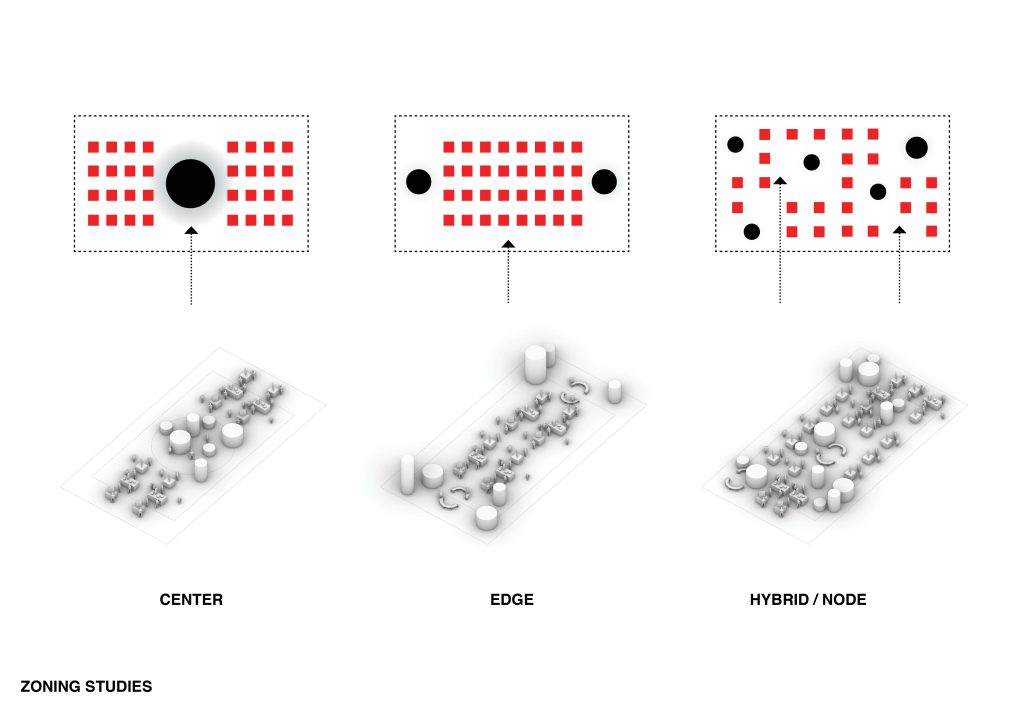
A Professional Touch
“In previous years, the ASA ALL MEMBER exhibition had revolved around various annually changing themes. Having attended each year, we began to question whether there could be more to it than just displaying beautiful objects and pavilions. When we were given the opportunity to curate this year’s event, we wanted to expand on this idea. Our goal was to elevate our profession to a higher level, allowing both professionals and the general public to understand the deeper aspects of our field,” explained Jaturon.
The showcased designs were the creative works of members from various professional associations, including the Association of Siamese Architects, the Thailand Interior Designers’ Association (TIDA), the Thai Urban Designers Association (TUDA), and the Thai Association of Landscape Architects (TALA). This collaborative exhibition aimed to present a comprehensive picture of these diverse professions, all interlinked through the design process. It reflected the cooperation among different professional fields, with exhibits arranged according to the order of submission. This year, the exhibition featured contributions from over a hundred participants, including existing members and new members, whether companies or individuals.
The space was meticulously planned and divided into two sections, showcasing works from members of the four professional associations. These displays included completed and incomplete designs, projects not realized in actual construction, and parts of the works. The exhibits were presented as three-dimensional objects or models and triangular plates mounted on black rectangular bases. Each piece was accompanied by a placard providing basic information and a QR code, revealing additional project details the participants submitted. This arrangement aligned with the curators’ vision of making the work processes of design professionals accessible and fostering knowledge exchange. The exhibition emphasized three key aspects of the design process of design studios: Process, People, and Place. Information related to these elements was given equal importance and presented through images and videos. These visuals were displayed on screens at the central point of the exhibition area, where visitors could relax on mattresses and watch.
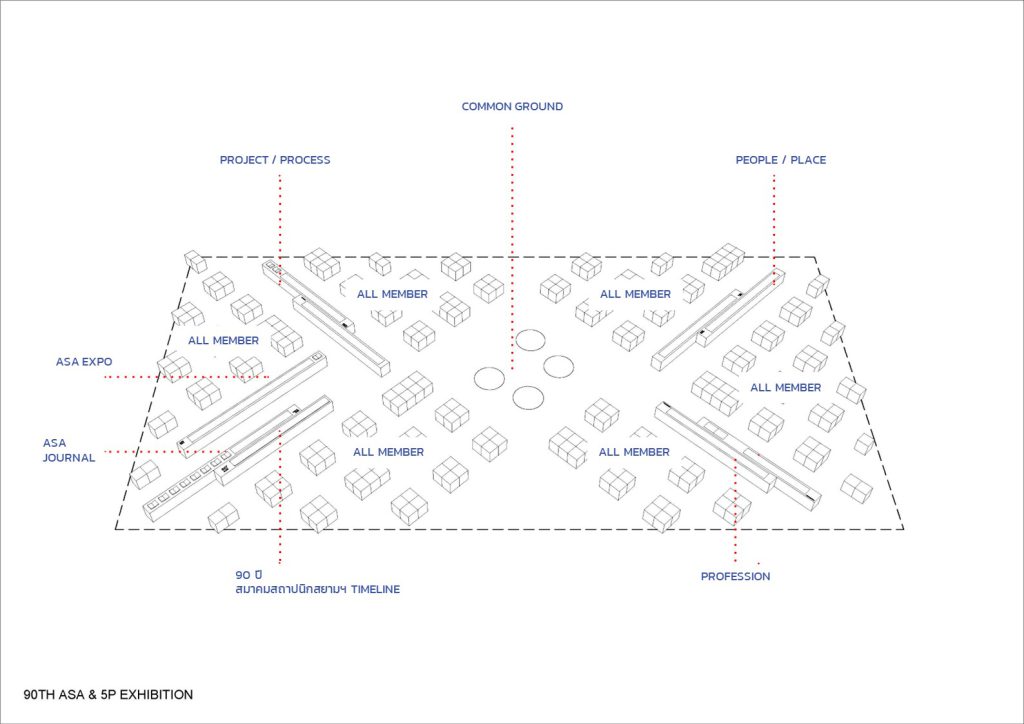
Crafting Senses from Information
Part of the exhibition was dedicated to elaborately arranged platforms parallel on either side of the space, effectively framing the three pivotal themes of Process, People, and Place. This section incorporated professional design work into its presentation, using questions and detailed research to provide historical and statistical data through infographics, which distilled complex ideas into easily understandable visuals. In celebration of the 90th anniversary of the Association of Siamese Architects Under Royal Patronage (ASA), this exhibition section also showcased an array of rare and valuable items, including early editions of ASA journals, books, and other foundational publications. An interactive area invited visitors to reflect on and contribute to discussions about ASA’s future by sharing their written thoughts. This provided viewers with a unique opportunity to learn through in-depth information and research along with related exhibits wrapped in important meanings, which has come to promote and create an exceptional learning experience
“The configuration of the exhibition platforms was deliberate and informative,” Yan elaborated. “The lower left platform was dedicated to celebrating ASA’s landmark 90th anniversary, featuring displays on the history of the ASA journal, the evolution of the architectural profession, and related subjects. Opposite this, the lower right platform defined the architect’s role, outlining their professional scope and educational frameworks. Above, the upper left platform demystified the architectural workflow, spotlighting the tools and processes of design. The upper right platform, meanwhile, visually explored the architects’ work environments, showing the diverse spaces from where they operated. Each platform integrated varied design contributions from ASA members, offering a holistic view of the profession.”
This year’s ASA ALL MEMBER exhibition was driven by a dynamic integration of meticulous research conducted by two curators with the actual exhibition. They had compiled a dataset from the design offices of participating members, enhanced by historical records from the association itself. It provided a holistic view of the architectural profession, enabling visitors to better understand architects’ origins and definitions and the evolution of their workspaces and tools. This investigation extended beyond local historical data, incorporating comparative analyses with global trends, highlighting international influences and local adaptations.
Additionally, the exhibition was enriched by a series of engaging questions posed to the participating members, accompanied by their responses. Queries such as “Will AI replace architects?”, “What future do you envision for the profession?” and “How should the public perceive architects?”
stimulated new dialogues and deepened people’s understanding. These conversations promoted further exploration and fostered diverse developments, evidenced by statements such as “Professions that enhance the quality of the built environment are essential in society and must be adapted to various contexts” and “Architects play a crucial role in shaping individuals, communities, and cities. Raising public awareness of this profession is crucial for promoting sustainable urban development and supporting the robust growth of the field.” This last point, featured in the final segment of the inquiry, exemplified the exhibition’s interactive and exploratory approach.
The ASA ALL MEMBER: Collective Practices exhibition at the Architect Expo 2024 played a pivotal role in expanding and deepening the general public’s understanding of the architectural profession. Its engaging format effectively drew attendees into dynamic interactions that fostered a greater appreciation of diversity within the field. Designed with interactivity at its core, the exhibition encouraged participating members to actively voice their opinions, transforming the space into a vibrant forum for dialogue and exchange. This shift from passive viewing to active participation prompted visitors to reflect, catalyzing the ongoing evolution and future developments of the exhibition. The diverse viewpoints converged into a multifaceted narrative, aligning beautifully with what the two curators had envisioned.
“Being at the exhibition every day, I observed various reactions from attendees in different scenarios. For instance, parents who accompanied their children, who were newly practicing architects, started to understand just how demanding their children’s work was. They came to understand that architecture involved not only design but also a substantial understanding of legal matters. From an educator’s perspective, it was fascinating to consider incorporating a timeline that weaved together economic, social, and political aspects into the curriculum. Additionally, members of the association who were not directly involved in this segment were eager to see the information live beyond the exhibition and be compiled and disseminated into books and websites, making it accessible to those who could not attend the event,” Said Yan.

อ่านบทความคอลัมน์อื่นๆ หรือดาวน์โหลดเล่มวารสารฉบับออนไลน์ 18 Collective Language คลิกได้ที่นี่
อ่านบทความคอลัมน์อื่นๆ หรือดาวน์โหลดเล่มวารสารฉบับออนไลน์ Collective Language: EPILOGUE คลิกได้ที่นี่


